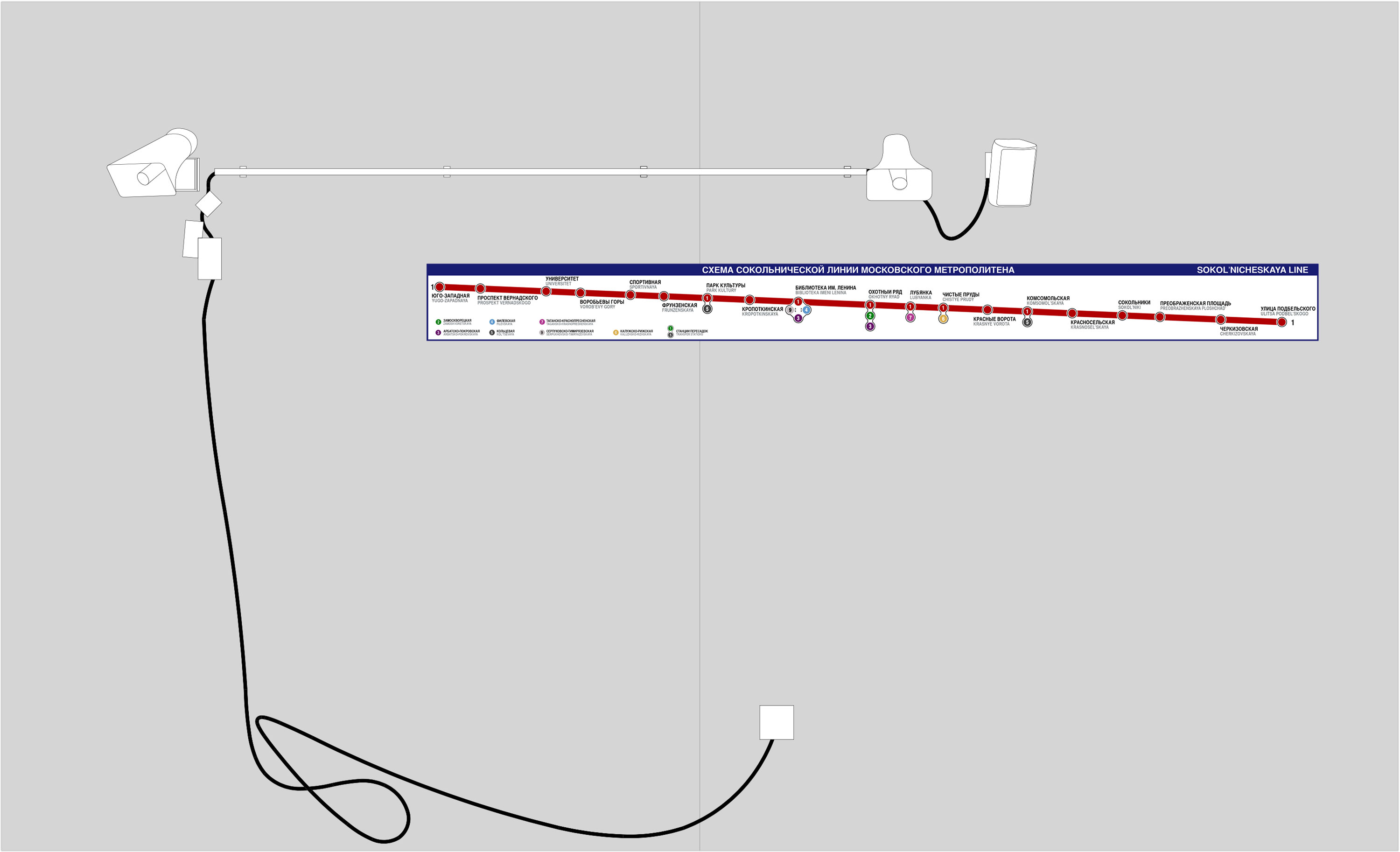
METRO LINE 1 / Sololnitscheskaja
Soundinstallation
The sound installation Metro Line 1 focuses on a sound recording: The automatic announcement speakers of the Moscow Metro Line 1 are the voices of well-known radio presenters. The interesting thing about this, is that the male voice speaks the announcements going into the city, while the female voice leads you out of the city. Three loudspeakers, a timetable of Line 1 and wall panel made of MDF are combined to form this installation. The materials and placement of the work are reminiscent of the Moscow subway and refer to how the benches are arranged in the carriages. “When I ride Line 1, I ride over bones“, said the Russian historian Yuri Prokhorov. The announcers‘ voices seem pleasant, but the squeaking and crashing of the carriages give you the feeling that the trains are struggling to pass through the tube tunnel. The natural overlapping of these auditory levels also highlight the exceptional toil and sacrifice made during the tunnels construction. It was a stand against Stalinism that has not been dealt with until today – rather it has been used to maintain political power. Metro 1 / Sokolnicheskaya was the first metro line to go into operation in Moscow in 1935, running from Bulwar Rokossovskovo to Salaryvo. For Soviet dictator Josef Stalin, the metro was a prestige project: the workers were recruited and heroised with typical Soviet propaganda. However, the working conditions were conceivably poor and the wear and tear on the labour force was great. The meagre rations and wages were existentially precarious and tunnel excavations were initially carried out without advanced technical aids: the workers had to start tunnel construction with pickaxes, shovels and wheelbarrows. Only when it became clear that the deadlines of this project could no longer be met without modern technical equipment, it was decided to buy a tunnel - boring machine from England. This was then copied on the basis of British design templates and thus possible for the first metro to go into operation on 6 February 1935.
Die Metro 1 / Sokolnitscheskaja wurde als erste Metro Linie 1935 in Moskau in Betrieb genommen und fährt auf der Strecke von Bulwar Rokossowskowo bis Salarjwo. Für Sowjetdiktator Josef Stalin war die U-Bahn ein Prestigeprojekt - die ArbeiterInnen wurden mit den typischen sowjetischen Propagandamaßnahmen angeworben und heroisiert. Allerdings waren die Arbeitsbedingungen denkbar schlecht und der Verschleiß an Arbeitskräften gross. Die dürftige Verpflegung und Entlohnung waren existenziell prekär und bei den Tunnelgrabungen wurde zuerst auf fortschrittliche technische Hilfsmittel verzichtet: mit Spitzhacke, Schaufel und Schubkarren mussten die ArbeiterInnen den Tunnelbau beginnen. Erst als sich herausstellte, dass die Terminvorgaben dieses Projekts ohne moderne technische Ausrüstung nicht mehr einzuhalten waren, beschloss man, eine Tunnelvortriebsmaschine aus England anzukaufen. Diese wurde dann anhand britischer Konstruktionsvorlagen nachgebaut und so war es möglich, dass die erste Metro am 6. Februar 1935 in Betrieb ging. In der Soundinstallation „Metro Line 1“ steht eine Tonaufnahme im Zentrum: Bei den SprecherInnen der automatischen Durchsagen handelt es sich um bekannte RadiomoderatorInnen. Eine weitere Besonderheit ist, dass die männliche Stimme die Ansagen stadteinwärts spricht, währende die weibliche Stimme aus der Stadt hinausführt. 3 Lautsprecher, ein Fahrplan der Linie 1 und eine Wandvertäfelung aus MDF werden zu einer Rauminstallation zusammengefügt. Die Materialien der Arbeit lehnen sich an die ursprüngliche Situation der U-Bahnen an, sie sollen auf die Anordnung der Sitzbänke an Warteräume verweisen. "Wenn ich mit der Linie 1 fahre, fahre ich über Knochen", sagte der russische Historiker Juri Prochorow. Die Stimmen der AnsagerInnen wirken angenehm, doch durch das Quietschen und Krachen der Waggons bekommt man das Gefühl, dass sich die Züge weigern, durch die Tunnelröhre zu fahren. Die natürliche Überlagerung dieser auditiven Ebenen verdeutlichen zugleich die Heroisierung und die Mühen und Opfer der ArbeiterInnen des Tunnelbaus. Es ist ein Stemmen gegen den Stalinismus der bis heute nicht aufgearbeitet wurde - vielmehr benutzt wird, um eine politische Macht zu erhalten.